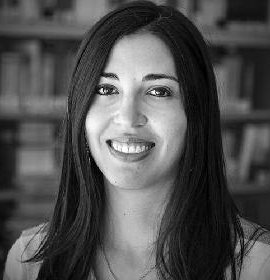Dr. Cecilia Nievas

Haus
A 70,
Raum
104 (Büro)
Telegrafenberg
14473
Potsdam
Funktion und Aufgaben:
Researcher in seismic risk.
Wissenschaftliche Interessen:
- Seismic hazard and risk assessment
- Building fragility and exposure
- Multi-hazard risk assessments
- Cascading and compounding events, cumulative damage and losses
- Consequences (damage, casualties) of small-to-medium magnitude earthquakes
- Exploration and assessment of regional and global earthquake databases
- Ground motion directionality
- Seismic design codes
- Seismic hazard input for the design of structures
- Spatial and modal combination rules for the design of structures
- Performance-Based Earthquake Engineering (PBEE)
- Direct Displacement-Based Design of structures
Karriere:
- 2019 – present: researcher at GFZ
- 2016 – 2019: independent consultant
- 2009 – 2011: assistant lecturer of Calculus I (Universidad Católica de Córdoba, Córdoba, Argentina)
- 2007 – 2011: junior structural engineer
Werdegang / Ausbildung:
- 2013 – 2016: Ph.D. in Understanding and Managing Extremes – XXIX Cycle – Curriculum in Earthquake Engineering and Engineering Seismology, Istituto Universitario di Studi Superiori di Pavia, Pavia, Italy
- 2011 – 2013: M.Sc. in Earthquake Engineering – Istituto Universitario di Studi Superiori di Pavia, Université Grenoble 1, University of Patras and Middle East Technical University – MEEES Programme carried out in Pavia (Italy) and Grenoble (France)
- 2011 – 2013: Master Sciences, Technologies, Santé, à finalité Recherche, Mention Sciences de la Terre et de l’Environment, specialité Terre Solide – Université Grenoble 1, Grenoble, France
- 2002 – 2008: Civil Engineer – Universidad Católica de Córdoba, Córdoba, Argentina
Projekte:
- CASCO (risk workflow for CAScading and COmpounding hazards in COastal urban areas) project of the Helmholtz "Changing Earth - Sustaining our Future" program: CASCO description.
- Development of a European High-Resolution Exposure (EHRE) model and the OpenBuildingMap(OBM) (GFZ). GitLab repositories: ehre-importer, ehre-core, ehre-exporter, OBM. (Prototype: ehre-prototype). Final report.
- RISE (Real-time earthquake risk reduction for a resilient Europe): European Union's Horizon 2020 research and innovation grant agreement No.821115. http://www.rise-eu.org/. Task leader (deliverable here). Developed the Real-Time Loss Tools (2023 SECED conference paper here).
- LOKI (Luftgestützte Observation Kritischer Infrastrukturen; Airborne Observation of Critical Infrastructures) project: funded by the German Federal Ministry for Education and Research (BMBF) under funding code (FKZ) 03G0890D (LOKI website at BMBF).
- Characteristics and consequences of earthquakes of low to medium magnitude, within the context of the Nederlandse Aardolie Maatschappij B.V. (NAM) project for Hazard and Risk Assessment for Induced Seismicity in Groningen, the Netherlands. Final reports: here and here.
- DBDsoft: development and modification of algorithms, graphical user interface, verification report, user manual and help system of DBDsoft, an earthquake engineering software developed within the Eucentre Foundation to aid in the application of the Direct Displacement-Based Design method.

